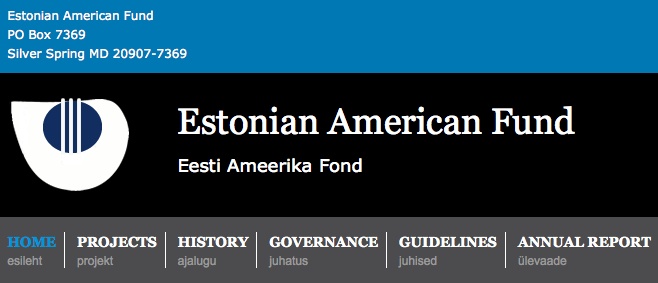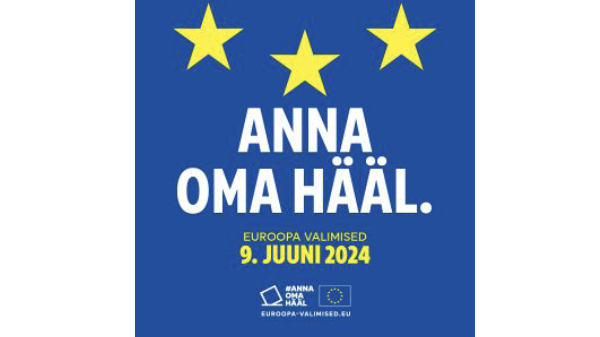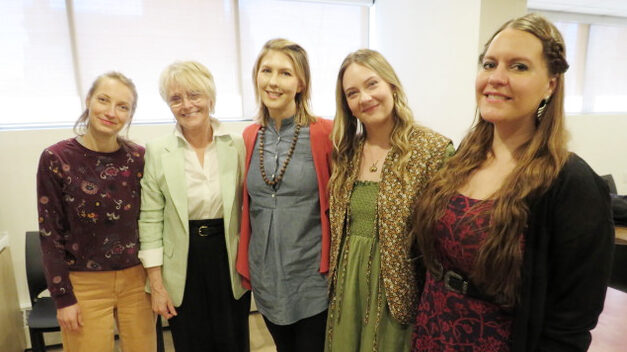Yet by the end of 1989 the Iron Curtain was more rust than iron. As communication channels opened up, opportunities beckoned to back up words with deeds, however modest. There was a place for an organization, free of political baggage, one that would enable those who were willing to lend a helping hand. Thus, in January 1990 the Estonian American Fund for Economic Education, Inc. began operating as a publicly supported charity, incorporated in Maryland and recognized as a publicly supported charity 501(c)(3)by the Internal Revenue Service. An invitation was extended to all people willing to contribute their expertise and resources to assist Estonia.
The long name was chosen to reflect political realities: U.S. policy and Gorbachev's perestroika favored economics and education. As the Fund's activities broadened, its popular name became the Estonian American Fund. No hyphen, because the operation is based on cooperation on both sides of the Atlantic.
The idea was to identify the needs in Estonia, and then to invite Estonians in the United States to develop projects to address those needs in cooperation with reliable partners in Estonia. As early as April 1990, the Fund began shipping scientific literature, mostly economics texts, to Tartu University and the Tallinn Technical University via Estonian Shipping Company bulk carriers on the Gulf ports- Port of Muuga route. Doubters in the U.S. objected: What if the Soviets confiscated the books? And why should we care: Moscow should provide for its own. The Fund bet on the goodwill of those involved. A risky undertaking turned out a success.
Early success spawned major projects, such as modernizing Estonian healthcare by providing donated CT scanners and X-Ray cabinets, training clinical engineers and technicians. Special thanks are due to two physicians, Dr. Bernard Schneider and Dr. Endel Sepp, who spared no effort in securing equipment donations.
Over a dozen 40- foot containers were shipped, packed with equipment, clothing, footwear and medicines. We partnered with the Sabre Foundation to expand the literature project, and with Direct Relief International to provide medicines and medical supplies worth several million dollars to Estonian hospitals and nursing homes.
When representatives of the World Bank visited Estonia that had restored her independence in August 1991, they were impressed by the fact that Estonian technicians had reassembled and were operating the donated high-tech diagnostic equipment, a finding that helped pave the way for loans to procure modern equipment for Estonian hospitals. It didn't hurt when representatives of the U.S. Agency for International Development found books donated by the Fund in university libraries. AID asked the Fund to register as an AID-approved voluntary foreign aid agency, and gave the Fund a grant to help defray shipping costs.
The Fund paved the way for Estonian professionals to participate in U.S. government training courses in economic statistics. Before independence, the U.S. position was that no Estonian government employee could be admitted to such programs. The first pre-independence attendee came in the spring of 1991 from the economics department of Tartu University. After recognizing Estonia's independence, the U. S. admitted professionals from the Estonian Statistical Office.
As times change, so do the Fund's projects. From assisting hospitals, the focus shifted to long-term care facilities, such as nursing homes, orphanages, and infants' homes, as financing these establishments was moved from the central government budget to local governments'. Local governments, especially outside the capital city, are having a hard time keeping up with growing needs.
For the Fund to supply 170 establishments with 7500 residents individually was out of the question. Instead, the Fund fostered a consortium in Estonia so that a large single shipment would go to one location that would serve as a distribution point. Each establishment now had to indicate its needs for specific medicines and supplies in a lengthy questionnaire. The questionnaires were consolidated into the consortium's national needs list. Each large single shipment would go to one location that would serve as the consortium's distribution center for the requested supplies and medicines.
To leverage its resources, the Fund entered into a partnership with Direct Relief International, Inc., a 60-year-old organization that has access to medical supplies and drug manufacturers. For instance, a modest contributions by the Fund enabled Direct Relief to assemble and ship containerloads of medicines and supplies valued at about 40 times the Fund's contribution. From 1996 to 2006, the project supplied 15 forty- foot containers, valued at $15 million. The feedback was positive: supplies were of high quality, and they were distributed fairly.
Another example of the multiplier effect was a donation of $2,000 that came with the instruction “to further youth activities in Estonia.” It set an example that elicited broad enough support to turn an idea for a Boy and Girl Scout Foundation in Estonia into reality with a seed capital of $60,000.
An endowment of $60,000, named MEDENT, was raised to enable young physicians and dentists to take advantage of “free”training opportunities abroad, provided that they can cover their transportation and living expenses. Scholarships have been endowed thanks to individual donations. A major scholarship was established by Mr. Andreas and Mrs. Elmerice Traks, M.D. that is administered by the Fund in cooperation with the Tartu University Foundation that screens applications and distributes the awards.
No project is too small, given volunteers willing to assume leadership. Thus, a school for the handicapped got needed physical training equipment thanks to a volunteer who enlisted her friends to raise $3000 needed for the purchase. Cooperation with other organizations such as the World Bank volunteers, the Sabre Foundation and the Washington Estonian Society made possible a shipment of 22,800 book shipment in 1995, including econometrics texts for Tartu University, and dictionaries and encyclopedias for 73 high schools with curricula that emphasize English.
A museum, KGB Kongid –Dungeons of the KGB– was opened in Tartu on October 12, 2001. Situated in the actual cells in the basement of the building that was the regional headquarters of the KGB, the museum documents the vilest outrages against humanity committed under the Soviet occupation. Innocent people by the thousands were “processed”. Many did not make it past the courtyard where KGB executioners practiced their trade. This museum is the first of its kind in Estonia. It was financed by the Estonian American Fund, thanks to a bequest of Tiit Lehtmets. The design and exhibits were provided by enthusiastic supporters in Estonia. An English language booklet, Crimes of Communism and the Struggle for Estonia's Freedom, was sponsored by the Fund. The historically correct, concise presentation of the 1939-1991 period in a handy format is appreciated by those who want an overview of that tragic era.
New projects are added as conditions change in Estonia. Suggestions are welcome, especially by those willing to contribute. For example, a much-needed youth home became reality in Eidapere in 2003, thanks to a $100,000 gift from Helmi and Vassili Kiik. As problems such as homelessness, child abuse, drug addiction, and poverty surfaced, the Fund channeled support to projects that address the needs of at-risk young people.
In addition to providing medical, economics, and political science literature, the Fund donated in 2003 an international law library to Tartu University. A complete computer science library was shipped to the Tallinn Technical University, thanks to a donation from the Institute of Electrical and Electronics Engineers in the United States.
What can the Fund show for the more than two and a half million dollars received from its supporters from 1990 to 2012? Here are the highlights: The single largest project delivered diagnostic equipment and medical technician training that made possible tens of thousands of life-saving observations. Large supplies of medicines and nursing supplies were supplied to long-term care facilities, orphanages, and hospitals.
Scholarship funds were established that pay for transportation and living expenses to enable young Estonian physicians and dentists take advantage of free training opportunities abroad. A Biomedical Technology and Medical Physics Science and Education Center was established at Tartu University, thanks largely to the efforts of Oleg Golubjatnikov, director of the Fund's medical technology transfer project. That project has branched out to cover also Latvia and Lithuania, and has taken on a life of its own under the name BaltMedTech.
Tens of thousands of textbooks, scientific literature, encyclopedias and dictionaries have been sent to universities and high schools. Large quantities of clothing and footwear were sent when the need was greatest in the early 1990s.
The Fund has helped found and has supported the development of non-governmental organizations in Estonia. In the United States the Fund welcomed initiatives by volunteers. In 1992, a group of volunteers provided substantial support for the first Olympic team that Estonia fielded after regaining her independence. Another group of volunteers ran a successful project to provide up-to-date equipment to amputees who make up Estonia's ParaOlympics sled hockey team. A major relief effort by the Estonian community in Los Angeles, called Merevärav, took advantage of the Fund's legal status and operated for several years as a project of the Fund. Another volunteer group in the Pacific Northwest obtained major donations in kind under the aegis of the Fund.
The Estonian Fund for Economic Education, Inc. was founded by Ago Ambre. Founding Board members were Maie Golubjatnikov, Henn Liiv, Oleg Golubjatnikov, Mark Ambre, Haldi U. Svanberg, Arvo B. Ederma, M.D., Prof. Thomas Palm, Maya Paabo, Erik Puskar. Rauno Joks, M.D, Liina Keerdoja, Tiina Urv, Ph.D., and Helmi L. Lutsep, M.D. have joined subsequently while Maya Paabo and Haldi U. Svanberg have retired from the Board. Board members serve without compensation.
About 400 individuals have contributed to the Fund, as have almost all Estonian organizations in the U.S.
You are invited. Estonia is still very much a work in progress. The Fund is an open organization: your expertise, ideas, and material support are welcome. Look up Guidelines on our website eafund.org. Contact us via Email: eafund@comcast.net.
Estonian American Fund




